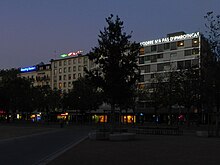Site-specific art

Site-specific art is artwork created to exist in a certain place. Typically, the artist takes the location into account while planning and creating the artwork. Site-specific art is produced both by commercial artists, and independently, and can include some instances of work such as sculpture, stencil graffiti, rock balancing, and other art forms. Installations can be in urban areas, remote natural settings, or underwater.[1][2][3][4][5][6]
History
The term "site-specific art" was promoted and refined by Californian artist
Modernist art objects were transportable, nomadic, could only exist in the museum space and were the objects of the market and commodification. Since 1960 the artists were trying to find a way out of this situation, and thus drew attention to the site and the context around this site. The work of art was created in the site and could only exist and in such circumstances - it can not be moved or changed. Site is a current location, which comprises a unique combination of physical elements: depth, length, weight, height, shape, walls, temperature.[14] Works of art began to emerge from the walls of the museum and galleries (Daniel Buren, Within and Beyond the Frame, John Weber Gallery, New York, 1973), were created specifically for the museum and galleries (Michael Asher, untitled installation at Claire Copley Gallery, Los Angeles, 1974, Hans Haacke, Condensation Cube, 1963–65, Mierle Laderman Ukeles, Hartford Wash: Washing Tracks, Maintenance Outside, Wadsworth Atheneum, Hartford, 1973), thus criticizing the museum as an institution that sets the rules for artists and viewers.[15]
Jean-Max Albert, created Sculptures Bachelard in Parc de la Villette related to the site, or Carlotta’s Smile, a trellis construction related to Ar. Co,’s architecture Lisbon, and to a choreography in collaboration with Michala Marcus and Carlos Zingaro, 1979.[16]
When the public debate over Tilted Arc (1981) resulted in its removal in 1989, its author Richard Serra reacted with what can be considered a definition of site-specific art: "To move the work is to destroy the work."[17]
Examples
Outdoor site-specific artworks often include

In Geneva, Switzerland, the Contemporary Art Funds are looking for original ways to integrate art into architecture and the public space since 1980.[18] The Neon Parallax project, initiated in 2004, is conceived specifically for the Plaine de Plainpalais, a public square of 95'000 square meters, in the heart of the city. The concept consists of commissioning luminous artistic works for the rooftops of the buildings bordering the plaza, in the same way, advertisements are installed on the city's glamorous lakefront. The 14 artists invited had to respect the same legal sizes of luminous advertisements in Geneva. The project thus creates a parallax both between locations, and messages, but also by the way one interprets neon signs in the public realm.[19]
Site-specific performance art, site-specific visual art and interventions are commissioned for the annual Infecting the City Festival in Cape Town, South Africa. The site-specific nature of the work allows artists to interrogate the contemporary and historic reality of the Central Business District and create work that allows the city's users to engage and interact with public spaces in new and memorable ways.[20]
Gallery
-
Robert Smithson, Spiral Jetty from atop Rozel Point, 2005.
-
Side effect X, Eberhard Bosslet; Tias, Lanzarote, 2008.
-
View of an installation from Strandbad Seedorf, Switzerland, 2015.
-
A rock balance, England, 2013.
-
The Globe,Knockan Crag National Nature Reserve, Scotland, 2007.
-
Olafur Eliasson's Waterfalls under the Brooklyn Bridge, 2008.
-
Site specific dance by Blue Lapis Light at the Texas State History Museum in Austin, Texas, 2010.
-
O, Die Stimme in der Kunst, Klinikverwartung, Milton Becerra, Germany, 1989.
See also
References
- ^ TACO, L. A. (2013-11-13). "Interview with Rafael Schacter, Author of the Amazing New Book: The World Atlas of Street Art and Graffiti". L.A. TACO. Retrieved 2022-07-22.
- ISSN 0362-4331. Retrieved 2022-07-22.
- ^ "Silence / Shapes – Filippo Minelli Studio". Retrieved 2022-07-22.
- ISBN 9780300199420.
- ^ "Rafael Schacter and His "World Atlas of Street Art and Graffiti"". Retrieved 2022-07-22.
- ^ Gravity Glue 2015, retrieved 2022-07-22
- ISBN 1558592725.
- ISBN 978-3791355146.
- ^ Chowdhry, Pritika (2021-11-06). "Site-Specific Art". Pritika Chowdhry Art. Retrieved 2021-11-06.
- ISBN 0-203-13829-5.
- ^ Chowdhry, Pritika (2021-11-06). "Site-Specific Art". Pritika Chowdhry Art. Retrieved 2021-11-06.
- ISBN 0-203-13829-5.
- ^ Kaye (citing O'Docherty's Inside the White Cube, 1986), p. 27
- ^ Kwon, p.3
- ^ Kwon, p. 13
- ^ "Abecedário — AR.CO — Centro de Arte e Comunicação Visual". www.arcoabecedario.pt. Retrieved 2018-10-26.
- ^ Kaye, p. 2
- ^ "Missions | Fonds d'art contemporain | Ville de Genève : Sites des institutions". institutions.ville-geneve.ch (in French). Retrieved 2018-01-05.
- ^ "NEON PARALLAX - Département de la culture et du sport - Ville de Genève". www.ville-ge.ch. Retrieved 2022-07-22.
- ^ "Infecting The City - Africa Centre". Africa Centre. 2014-03-28. Retrieved 2018-01-05.
External links
 Media related to Site-specific art at Wikimedia Commons
Media related to Site-specific art at Wikimedia Commons








